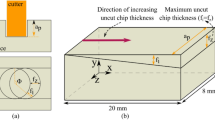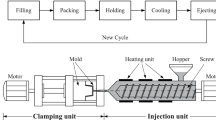Abstract
In this paper, the injection molding technique is selected, and different internal and external defects have been evaluated, including warpage, short shot, and shrinkage. Different geometric and injection machine inputs such as gate type, filling time, part cooling time, holding pressure time, and melt temperature have been chosen, respectively. The Taguchi method is applied to find the best level of each parameter. In recent years, researchers have been focused on using machine learning techniques with a combination of meta-heuristic methods to calculate the optimal process parameters in injection molding to increase the quality of the final product. However, the computational load of the machine learning methods and meta-heuristic algorithms is far behind in handling real-time applications. The main motivation of this study is to reach an accurate model with a low computational load to handle the real-time computational load even in the presence of lower CPU power controller mechanisms. Then, the genetic programming method is employed to extract the optimal mathematical model of the injection-molding process, which relates the processing parameters, including part cooling time, filling time, melt temperature, and holding pressure time, to output which is the combination of shrinkage rate, short shot, and warpage. The extracted optimal mathematical formulation of the genetic programming method is employed inside the interior point nonlinear programming solver via the fmincon function of MATLAB software to calculate the optimal parameters of the process as fast as possible. The genetic programming results are compared with previous methods such as decision tree, support vector regression, and multilayer perceptron to prove the acceptable accuracy of the first part of the paper with the lower computational load. Then, the means square error between the finite element method and the extracted result using the hybrid genetic programming and interior point nonlinear programming solver is 47.06%, 93.75%, and 83.63% lower than previous methods, including decision tree, support vector regression, and multilayer perceptron, respectively.












Similar content being viewed by others
Data availability
All data used in this work have been properly cited within the article.
Code availability
The authors declare that there is no code to report regarding the present study.
References
Shi H, Xie S, Wang X (2013) A warpage optimization method for injection molding using artificial neural network with parametric sampling evaluation strategy. The Int J Adv Manuf Technol 65(1):343–353
Hassan H et al (2010) Modeling the effect of cooling system on the shrinkage and temperature of the polymer by injection molding. Appl Therm Eng 30(13):1547–1557
Moayyedian M, Abhary K, Marian R (2017) The analysis of short shot possibility in injection molding process. The Int J Advanced Manuf Technol 91(9):3977–3989
Moayyedian M, Abhary K, Marian R (2016) Gate design and filling process analysis of the cavity in injection molding process. Advances in Manufacturing 4(2):123–133
Moayyedian M, Abhary K, Marian R (2018) Optimization of injection molding process based on fuzzy quality evaluation and Taguchi experimental design. CIRP J Manuf Sci Technol 21:150–160
Pandelidis IO, Kao J-F (1990) DETECTOR: A knowledge-based system for injection molding diagnostics. J Intell Manuf 1(1):49–58
Lee B, Kim B (1995) Optimization of part wall thicknesses to reduce warpage of injection-molded parts based on the modified complex method. Polym-Plast Technol Eng 34(5):793–811
He W et al (1998) Automated process parameter resetting for injection moulding: a fuzzy-neuro approach. J Intell Manuf 9(1):17–27
Qazani, MRC, et al (2022) Estimation of tool–chip contact length using optimized machine learning in orthogonal cutting. Engineering Applications of Artificial Intelligence Accepted recently.
Lotti C, Ueki M, Bretas R (2002) Prediction of the shrinkage of injection molded iPP plaques using artificial neural networks. J Injection Molding Technol 6(3):157
Mok S, Kwong CK (2002) Application of artificial neural network and fuzzy logic in a case-based system for initial process parameter setting of injection molding. J Intell Manuf 13(3):165–176
Kurtaran H, Erzurumlu T (2006) Efficient warpage optimization of thin shell plastic parts using response surface methodology and genetic algorithm. The Int J Advanced Manufacturing Technol 27(5):468–472
Gao Y, Turng LS, Wang X (2008) Adaptive geometry and process optimization for injection molding using the Kriging surrogate model trained by numerical simulation. Advances in Polymer Technology: J Polymer Processing Institute 27(1):1–16
Hassan H et al (2009) Effect of cooling system on the polymer temperature and solidification during injection molding. Appl Therm Eng 29(8–9):1786–1791
Tang LQ, Chassapis C, Manoochehri S (1997) Optimal cooling system design for multi-cavity injection molding. Finite Elem Anal Des 26(3):229–251
Yin F et al (2011) Back propagation neural network modeling for warpage prediction and optimization of plastic products during injection molding. Mater Des 32(4):1844–1850
Tsai K-M, Luo H-J (2017) An inverse model for injection molding of optical lens using artificial neural network coupled with genetic algorithm. J Intell Manuf 28(2):473–487
Abbasalizadeh M et al (2018) Experimental study to optimize shrinkage behavior of semi-crystalline and amorphous thermoplastics. Iran J Mater Sci Eng 15(4):41–51
Khosravani MR, Nasiri S (2020) Injection molding manufacturing process: Review of case-based reasoning applications. J Intell Manuf 31(4):847–864
Abdul R et al (2020) Shrinkage prediction of injection molded high density polyethylene parts with taguchi/artificial neural network hybrid experimental design. Int J Interactive Design and Manufacturing (IJIDeM) 14(2):345–357
Song Z et al (2020) Optimization and prediction of volume shrinkage and warpage of injection-molded thin-walled parts based on neural network. The Int J of Adv Manufacturing Technol 109(3):755–769
Torres-Alba A et al (2021) A hybrid cooling model based on the use of newly designed fluted conformal cooling channels and fastcool inserts for green molds. Polymers 13(18):3115
Torres-Alba A et al (2021) Application of new triple hook-shaped conformal cooling channels for cores and sliders in injection molding to reduce residual stress and warping in complex plastic optical parts. Polymers 13(17):2944
Mercado-Colmenero JM et al (2021) A new conformal cooling system for plastic collimators based on the use of complex geometries and optimization of temperature profiles. Polymers 13(16):2744
Gao, Z, et al.(2021) Machine learning aided design of conformal cooling channels for injection molding. Journal of Intelligent Manufacturing 1–19.
Li, Y, JC. (2021) Chen, and W.M. Ali, Process optimization and in-mold sensing enabled dimensional prediction for high precision injection molding. International Journal on Interactive Design and Manufacturing (IJIDeM) 1–17.
Speranza V et al (2021) Prediction of morphology development within micro–injection molding samples. Polymer 228:123850
Jung H et al (2021) Application of machine learning techniques in injection molding quality prediction: implications on sustainable manufacturing industry. Sustainability 13(8):4120
Uğuroğlu, E. (2021) Near-real time quality prediction in a plastic injection molding process using Apache spark. in 2021 International Symposium on Computer Science and Intelligent Controls (ISCSIC). 2021. IEEE.
Párizs, RD, et al.(2022) Machine learning in injection molding: an industry 4.0 method of quality prediction. Sensors, 22(7): p. 2704.
Ke K-C, Huang M-S (2022) Enhancement of multilayer perceptron model training accuracy through the optimization of hyperparameters: a case study of the quality prediction of injection-molded parts. The Int J Adv Manufacturing Technol 118(7):2247–2263
Koza JR, Poli R (2005) Genetic programming. Search methodologies. Springer, pp 127–164
Koza, J.R., Genetic programming II. Vol. 17. 1994: MIT press Cambridge.
Moayyedian M, Derakhshandeh JF, Said S (2019) Experimental investigations of significant parameters of strain measurement employing Taguchi method. SN Applied Sciences 1(1):1–9
Mojaver M et al (2022) Comparative study on air gasification of plastic waste and conventional biomass based on coupling of AHP/TOPSIS multi-criteria decision analysis. Chemosphere 286:131867
Azdast T et al (2019) Investigation of mechanical and morphological properties of acrylonitrile butadiene styrene nanocomposite foams from analytical hierarchy process point of view. Polym Bull 76(5):2579–2599
Daryadel M et al (2018) Simultaneous decision analysis on the structural and mechanical properties of polymeric microcellular nanocomposites foamed using CO2. J Appl Polym Sci 135(14):46098
Molani S et al (2018) A Taguchi analysis on structural properties of polypropylene microcellular nanocomposite foams containing Fe2O3 nanoparticles in batch process. Plast, Rubber Compos 47(3):106–112
Mosavvar A et al (2019) Tensile properties of friction stir welding of thermoplastic pipes based on a novel designed mechanism. Welding in the World 63(3):691–699
Nocedal, J. and S.J. Wright, Interior-point methods for nonlinear programming. Numerical Optimization, 2006: p. 563–597.
Silva, S. A Genetic Programming Toolbox for MATLAB. 2018 [cited 2022 29/04/2022]; Available from: http://gplab.sourceforge.net/index.html.
Pedrammehr S et al (2022) Machine learning-based modelling and meta-heuristic-based optimization of specific tool wear and surface roughness in the milling process. Axioms 11(9):430
Qazani MRC, Parvaz H, Pedrammehr S (2022) Optimization of fixture locating layout design using comprehensive optimized machine learning. The Int J Adv Manufact Technol 122(5):2701–2717
Kumar, K, et al. (2021) SpinalXNet: Transfer learning with modified fully connected layer for X-ray image classification. in 2021 IEEE International Conference on Recent Advances in Systems Science and Engineering (RASSE). IEEE.
Khanam, S., et al.(2022) CoV-TI-Net: transferred initialization with modified end layer for COVID-19 diagnosis. arXiv preprint arXiv:2209.09556
Qazani MRC et al (2021) Prediction of motion simulator signals using time-series neural networks. IEEE Trans Aerosp Electron Syst 57(5):3383–3392
Qazani, MRC, et al. (2021) Time series prediction of driving motion scenarios using fuzzy neural networks:* Motion Signal Prediction Using FNNs. in 2021 IEEE International Conference on Mechatronics (ICM). IEEE.
Funding
The authors declare that there is no funding to report regarding the present study.
Author information
Authors and Affiliations
Contributions
Mehdi Moayyedian: investigation, data curation, writing—original draft, writing—review and editing, visualization, supervision, project administration, supervision; Mohammad Reza Chalak Qazani: conceptualization, methodology, software, validation, writing—original draft, writing-review and editing, visualization; Vahid Pourmostaghimi: writing—review and editing, conceptualization, methodology, software.
Corresponding author
Ethics declarations
Ethics approval
Not applicable.
Consent to participate
The authors declare that all authors have read and approved to submit this manuscript to IJAMT.
Consent for publication
The authors declare that all authors agree to sign the transfer of copyright for the publisher to publish this article upon acceptance.
Competing interests
The authors declare no competing interests.
Additional information
Publisher's Note
Springer Nature remains neutral with regard to jurisdictional claims in published maps and institutional affiliations.
Rights and permissions
Springer Nature or its licensor (e.g. a society or other partner) holds exclusive rights to this article under a publishing agreement with the author(s) or other rightsholder(s); author self-archiving of the accepted manuscript version of this article is solely governed by the terms of such publishing agreement and applicable law.
About this article
Cite this article
Moayyedian, M., Qazani, M.R.C. & Pourmostaghimi, V. Optimized injection-molding process for thin-walled polypropylene part using genetic programming and interior point solver. Int J Adv Manuf Technol 124, 297–313 (2023). https://doi.org/10.1007/s00170-022-10551-2
Received:
Accepted:
Published:
Issue Date:
DOI: https://doi.org/10.1007/s00170-022-10551-2




